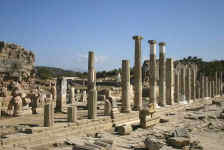Magnesia is located at Tekinköy, near Ortaklar district of Aydin province in the Aegean region of Turkey, about 100 kilometers (62 miles) south of Izmir. The ruins are located on the side of the main road connecting Ortaklar to Söke and there are permanent ongoing excavations since 1984.
 According to the legends and ancient sources, Magnesia was founded by settlers called as Magnetes who came from Thessalia (Thessaly) on Greek mainland, following an oracle of Apollo and led by their leader Leukippos. The location of the first city of Magnesia is not known, but it's said to be somewhere along the Meander river (today's Büyük Menderes) near Bafa Lake, which was a bay on the Aegean Sea back then so it was accessible by the boats. Due to the epidemic outbreaks caused by the continuous changing of the river bed of the Meander and for the fact of being open to Persian invasions, around 400 BC Magnetes moved their city to its actual location next to Gumuscay river. During the Hellenistic period Magnesia was ruled by Seleucos and then by the Kingdom of Pergamon. The city preserved its status during the Roman period and became a religious center during the Byzantine period.
According to the legends and ancient sources, Magnesia was founded by settlers called as Magnetes who came from Thessalia (Thessaly) on Greek mainland, following an oracle of Apollo and led by their leader Leukippos. The location of the first city of Magnesia is not known, but it's said to be somewhere along the Meander river (today's Büyük Menderes) near Bafa Lake, which was a bay on the Aegean Sea back then so it was accessible by the boats. Due to the epidemic outbreaks caused by the continuous changing of the river bed of the Meander and for the fact of being open to Persian invasions, around 400 BC Magnetes moved their city to its actual location next to Gumuscay river. During the Hellenistic period Magnesia was ruled by Seleucos and then by the Kingdom of Pergamon. The city preserved its status during the Roman period and became a religious center during the Byzantine period.
During its heydays Magnesia was a big city positioned within the triangle of Priene, Ephesus and Tralles (ancient Aydin) holding its strategical and commercial importance. The city had a grid plan and was surrounded by a big wall, covering an area of a 1,5 kilometers (1 mile) of diameter. Magnesia was never badly destroyed as happened with many other ancient cities in the region, most of the ruins today are intact. This was due to the flooding and silting up caused by the river, covering whole city but protecting it from the treasure hunters for many centuries.
First excavations in Magnesia started in 1891 by Carl Humann from the University of Berlin and lasted for about 2 years, during which partial or complete sections of the theater, prytaneion, temple and altar of Artemis, agora, and the temple of Zeus were un-earthed from the heavily sedimented site. The objects found during the excavations are displayed in museums in Paris, Berlin and Istanbul. After a long silence from this first excavation, almost after 100 years, in 1984 the Ministry of Culture and the University of Ankara have resumed the excavations of Magnesia which was covered with dirt again during the past years.
The most important ruin in Magnesia is the temple of Artemis which was built by architect Hermogenes, a famous architect in the ancient times who invented the octagonal pseudo-dipteros plan for the temples. The temple of Artemis, or the Artemision that we see today in Magnesia, is from the Hellenistic period around late 3rd - early 2nd century BC, built on the foundations of an earlier building dating back to the Arcaic period around 6th century BC. The temple is in Ionic style with 8 x 15 columns covering an area of 67 x 40 meters (220 x 131 feet), making it one of the biggest temples in Anatolia. According to Strabo, this was the third greatest temple after those in Didyma and Ephesus. The U-shaped huge altar facing the temple was decorated with friezes and statues.
The theater of Magnesia is dating back to the 2nd century BC and has a classic shape. The Agora and the Zeus altar were most probabily built by Hermogenes again around the beginning of the 2nd century BC. The agora covers an area of 26 thousand square meters (6,5 acres) and was one of the biggest bazaars of that period in Asia Minor.
Other ruins that can be seen today in Magnesia are mostly from the Roman period and some from the Byzantine period. These are gymnasion, bath complex, odeon, stadion with a capacity of 25 thousand spectators, basilica and the byzantine wall. The only Ottoman building at the site is the 15th century Çerkez Musa mosque. The excavations are still going on at Magnesia and there are still lots to explore.

